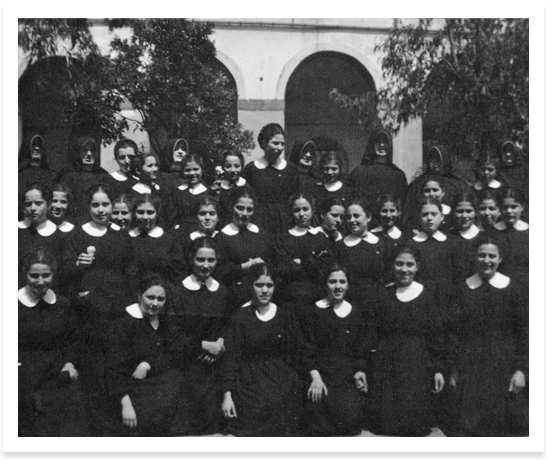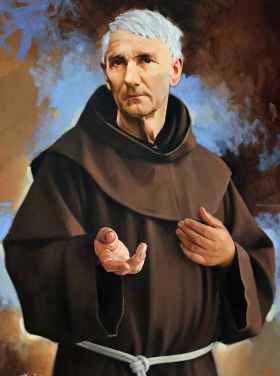 Faith is the vision of God, it inflames the soul, illuminates the mind, and puts all of man to work
Faith is the vision of God, it inflames the soul, illuminates the mind, and puts all of man to work
 Faith is the vision of God, it inflames the soul, illuminates the mind, and puts all of man to work
Faith is the vision of God, it inflames the soul, illuminates the mind, and puts all of man to work

The Franciscan Sisters of Saint Elizabeth were founded by Saint Ludovico of Casoria, O.F.M. with the assistance of Margherite Salatino in Naples, Italy in 1862. Margherite Salatino not only served as co-foundress but was also the first Superior General of the Congregation. Our Congregation received its final Papal Approbation on July 16, 1943.
Originally Saint Ludovico’s women’s congregation was known as the Bigie or Gray Sisters. After observing the good works of some Elizabethan Sisters, Saint Ludovico placed his new community under the protection of Saint Elizabeth of Hungary, the Queen Patroness of the Franciscan Third Order. Today we are known globally as the Franciscan Sisters of Saint Elizabeth. We observe the Rule of the Third Order Regular of Saint Francis of Assisi.
Chief among the purposes in founding this Institute of Religious Women was the caring for African children ransomed from slavery.
The Franciscan Sisters of Saint Elizabeth soon undertook more and more of the charitable works begun by this humble Franciscan Friar. We were involved in working in hospitals, orphanages, parishes, all levels of schools, homes for the poor and aging, and as catechetical instructors. Much of Saint Ludovico’s work continues today and it has expanded to circle the globe.
The object of the Congregation is the personal sanctification of its members through the imitation of the apostolic labors of their Incarnate Savior. We Sisters strive to imitate the poor, chaste, and humble life of Jesus Christ. We observe the vows of poverty, chastity, and obedience by following the example of Saint Francis of Assisi, the faithful imitator of Christ, and Saint Elizabeth of Hungary, one of the most illustrious of the daughters of Saint Francis. We devote ourselves and all we possess to Christ the Savior as our Mystical Spouse, sacrificing to Him our heart and body by chastity, our minds and wills by obedience, and our external goods by poverty. As we strive after personal perfection, we Sisters endeavor to devote ourselves to the service of suffering humanity by the performance of our works of Christian charity and mercy, especially to the needy and suffering poor.
Our Mother House and Novitiate (Formation House) was established in Rome, Italy. Since then, convents have been set up throughout Italy, the United States of America, India, Ethiopia, Panama, the Philippines, and Indonesia.
A small group of Franciscan Sisters of Saint Elizabeth traveled a great distance by ship to reach the shores of the United States of America in 1919. They took up residence in New Jersey, New York, and Indiana. Today in the United States we serve in New Jersey, Florida, and Missouri.
The Franciscan Sisters of Saint Elizabeth live by the examples set before us first by our Lord Jesus Christ, and then by the Saints. Their dedication to spread the Gospel message of service, love, and obedience throughout the ages brings guidance to our work in the modern day.

The life of Saint Ludovico of Casoria began on March 11, 1814 in Casoria, Italy under the birth name of Arcangelo Palmentieri. In order to learn a trade, his father arranged for him to apprentice as a cabinet maker in his youth. At age 18, he entered the novitiate of the Order of Friars Minor at which time he took the name Ludovico. He was ordained a priest in 1837 and soon after, Ludovico became a teacher of philosophy and mathematics. While praying in the presence of the Blessed Sacrament in the church of the Sacramentine Sisters in Naples in 1847, he had a spiritual experience—one which was a “rebirth” to a new life. The first people who witnessed the change in Father Ludovico were his students, who one day saw him entering the classroom wearing a habit made out of inexpensive fabric and rough sandals. He told his students, “I want to imitate Saint Francis.” The reaction was one of surprise.
From the day of the rebirth forward, Father Ludovico consecrated himself fully to the service of the poorest and neediest people. His lifetime of establishing works to care for the poor and needy in the Naples area of Italy commenced with establishing a dispensary in his friary to provide care for the elderly members of his own Order. He then established orphanages and opened a school for the education of African boys and girls ransomed from slavery. Father Ludovico wanted to educate the freed slaves then allow them to return to their home country to help educate people. Father Ludovico was a practical man. He preferred concrete action in carrying out his apostolates.
He would often repeat that he was just an old carpenter. His secret was his faith and conviction, and the belief that with the help of Divine Providence, anything could be accomplished.
Following the advice of his superiors to find others to whom he could entrust his many works, in 1859 he instituted a community of men as a religious congregation of the Franciscan Third Order Regular. They became known as the Gray Friars of Charity (Italian: Frati Bigi della Carità) on account of the traditional gray color of the Franciscan religious habit. The friars received formal approval by the Vatican in 1877, by which time their work had spread to the United States, where they served the Italian-American community in New Jersey. The friars were disbanded in 1971 by the Holy See due to the few members of the congregation. A new group of men, dedicated to his vision, however, is currently in the process of forming.
In 1862, Father Ludovico instituted a congregation of religious women, known as the Franciscan Sisters of St. Elizabeth (Suore Elisabettine Bigie), whom he placed under the protection of St. Elizabeth of Hungary, one of the first members of the Third Order of St. Francis and its patroness. With the establishment of the new religious community, Ludovico moved to entrust the orphans and African girls to the new foundation. The Franciscan Sisters of Saint Elizabeth, faithful to the charism left to them by Father Ludovico, have continued their charitable work in more than 40 institutions in Europe, Africa, Asia, and the Americas.
In 1871, he established a school for the deaf, mute, blind, and those with multiple disabilities in Assisi. Visitors who go to Assisi can still see one of the most modern institutes founded by Father Ludovico, which is just a few steps from the Basilica of Saint Francis of Assisi.
Ludovico of Casoria was a man ahead of his times. He encouraged the apostolate of the laity and dialogue with different cultures with the goal of enlivening society with the light of the Gospel. It is recorded that Father Ludovico had the charisma to attract people to his initiatives who were willing to work for God’s Love. One day a friend asked him how many institutions and projects he had established about Naples. It is estimated that Ludovico started over 200 projects all dedicated to the service of the poor and needy. When companions were questioned about the number of institutions and projects, the response would be, “There is neither the need nor the possibility to make a list of all the institutions of charity that Father Ludovico founded. It would be very tedious work to write a list of all of his institutions. In fact, it would be surely incomplete. Many of his institutions had brief lives because they were created to respond to particular needs of the present time, as they occurred. Eternity belongs only to God.” He became involved in so many social and cultural works throughout his life, his contemporaries dubbed him “Saint Francis of the 19th century”.
Nine years before Ludovico's death, he was attacked with a serious and painful illness, from which he never completely recovered. Sister Death came to him the morning of March 30, 1885 in Naples.
The cause for Ludovico's canonization was introduced in Rome within months of his death. He was beatified in 1993 by Pope John Paul II and was canonized on November 23, 2014 by Pope Francis.
Father Ludovico, himself, wrote in his testament: “The love of Christ wounded my heart."

Francis Bernadone was born in 1182 in Assisi, Italy into a middle class family where his father was a silk merchant. Francis was known as a person who loved his friends and loved a good party. Francis was said to have been charming, fun-loving, and possessing great leadership qualities, which attracted people to him.
Francis’ dream was to become a great knight of the noble class and fight in great battles to win esteem and glory for himself—or so he thought. Francis’ first opportunity to serve as a knight came when Assisi declared war on their neighboring town of Perugia. Unfortunately, many of the men from Assisi were killed in this battle. Francis was made a prisoner of war and spent over a year serving in a dungeon. Remarkably, as Francis regained his health and spirit, he became his joyous self again. Eventually he was given his freedom and he returned to the town of Assisi. Soon a call for knights came to the men of Assisi to join the Fourth Crusade. This was Francis’ golden opportunity to fulfill his dream of serving as a knight.
While riding along the road, proud to be suited as a knight, Francis had a dream. God told him he had it all wrong and that he should return to Assisi immediately.
Francis listened and turned back. Historians suspect Francis must have been torn between the humiliation he faced and the heartfelt faith he felt deep in his heart.
Upon his return home, Francis began a slow transformation by becoming more and more a man of prayer. First God had to wait for Francis then Francis had to wait for God. When Francis was twenty five years old his true conversion began. One day while Francis rode through the countryside, he came face to face with a leper. This encounter reminded him of his aversion to sickness and deformity. Though disgusted by the appearance and the smell of the leper, Francis jumped down from his horse and kissed the leper. His kiss offering of peace was returned and suddenly Francis was filled with a joy and happiness that he had never experienced before. As he rode off, he turned around to wave goodbye, and saw that the leper had disappeared.
Along his spiritual journey Francis came upon an old broken down Church at San Damiano. While he was praying in the church, he heard Christ on the crucifix speak to him, “Francis, go out and repair my church for it is nearly falling down."
Francis thought this message meant church with a small “c”—the decaying building he was in. So Francis took silk fabric from his father’s shop and sold it to get money to repair the church. His father became angry with Francis and dragged him before the bishop and in the center of town to demand his money be returned. The Bishop embraced Francis and told him to return the money. He told him to trust that God would provide and Francis followed the Bishop’s request. Then Francis set out to repair the church. As he worked, more and more men joined him. Soon Francis had twelve companions helping with the work. This step of faith led Francis to form a religious community, not of his own plans, but of God’s plans.
The Poor Man of Assisi, as Francis was known, was a small simple man who followed in the footsteps of Jesus by living a life based on the Gospel message and brought much to many.

St. Elizabeth was born into the royal family of Hungary, in 1207. In 1211, an arrangement was made for four year old Princess Elizabeth to be married to the eldest son of Hermann I, Landgrave of the German region of Thuringia. The match provided advantages for both families—Thuringia would profit from the financial wealth Elizabeth would bring, and Hungary stood to gain political support against other German princes who threatened to invade the country. With a lavish dowry, including gold pieces and a solid silver bathtub, the young Elizabeth was sent to live at the Thuringian court at Wartburg Castle near Eisenach.
In 1213 Elizabeth's mother, Gertrude, living in Hungary was murdered. Then in December, 1216, Elizabeth’s betrothed died and she was then promised in marriage to a second son, Ludwig. In 1221, Ludwig, at the age of 21 and Elizabeth 14 were married. Ludwig and Elizabeth truly loved one another and Ludwig was a very fair ruler of the land. He also was a great soldier. Elizabeth believed in participating in acts of charity and dedicating her own self to prayer, penance, and vigils. Ludwig was very supportive in all of her endeavours. Their happy marriage produced three children, Hermann II, Sophia, and Gertrude. Elizabeth was generous and often gave alms to the poor in the Thuringia area. When Ludwig would be off traveling with his soldiers, he would return to hear about Elizabeth’s charitable works from the staff at Wartburg Castle, in which Ludwig would support his wife’s kindness.
In 1221 some of the followers of St. Francis of Assisi traveled to Elizabeth’s area of Germany to preach.
Elizabeth heard the Franciscan Friars preaching and soon embraced the simple life of prayer and giving. Soon they became her spiritual directors. Elizabeth was rich in material because of her marriage, but learned how to live simply and how to liberally give alms.
Sadly in September 1227 Ludwig died while marching with the Crusades. Elizabeth was a widow with three young children after only six years of marriage. She had had lost her beloved husband and she knew her life would never be the same.
Shortly after her husband’s death, a person would enter her life that would completely change her life forever. Conrad of Marburg, a local priest became Elizabeth’s spiritual director. He was extremely harsh with her and his demands of self-mortification for Elizabeth were excessive and severe. Unfortunately, as Elizabeth was working toward Heaven, her in-laws were unaccepting of her behavior.
In the winter of 1227, Elizabeth and her three children left the Wartburg castle. Elizabeth was ready to truly embrace the life of the poor. On Good Friday, 1228, Elizabeth and two servants who had followed her from the Wartburg, renounced the world and were clothed as tertiary members of the Third Order of St. Francis. Elizabeth’s lifework included aiding the poor and working at a twenty seven bed hospital that she had earlier built while living at Wartburg. The severity of her mortifications and living in poor conditions led to an early death. On November 17, 1231 at just 24-years-old, Elizabeth died. Miracles began to be reported soon after her death by her graveside.
Elizabeth officially was named a saint of the Catholic Church on May 26, 1235.
On May 1, 1236, her remains were brought to the church and placed on the altar in a ceremony attended by her children and in-laws as well as several bishops and archbishops. Large crowds of religious pilgrims from across Europe also came to pay tribute to the woman who had provided an inspiring example of a life of service to others.
Her symbols are: alms, flowers, bread, the poor, and a pitcher.
Saint Elizabeth of Hungary is the patron saint of: Bakers, death of children, falsely accused, the homeless, nursing services, tertiaries, widows, and young brides.
Copyright © 2024 franciscansister.com - All rights reserved
Designed By: JustCQ